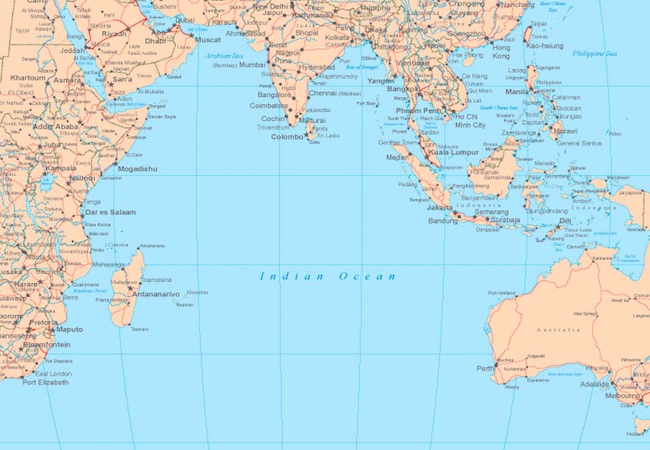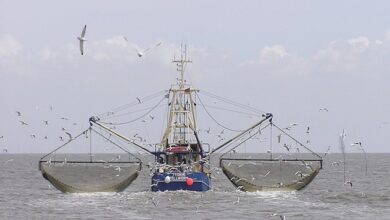The US offshore balancing strategy in the Indian Ocean region

By Zahid Khan
US offshore balancing in the South Asia region is not contemporary and is accredited to the geo-strategic idea of Sir Olaf Caroe, the last foreign secretary for the British raj in India (1939-45).[1]
As the British grip was curtailed, Caroe began to worry and what he came to call, in a visionary phrase, ‘the wells of power’, the oil resources of the Middle East in general and of the Gulf and the Arabian Peninsula in particular.[2] When the British perceived their slumping of power and therefore, mitigation influence in the region ostensibly persuade the US to infiltrate in the region when the US had no consequential interests.[3]
During the late 1940s, a committee was established to gaze into the planning stipulation of the Indian Arm forces.[4] The committee report based on three assumptions: one of which patently sequential for the foundations of “offshore balancing”—China and India would perpetuate adequate forces to control a minor power until the Imperial Forces could arrive. However, the report also mentioned the apprehensions of India coming underneath the Russia’s influence and delineate of China as a long-term threat. China is still observed as a threat, and although the threat from Russia sub-sided after the end of the cold war, its re-entry in to the IOR is a possibility given the rising debate on its growing proximity with China and pivot to Asia [5] and plans to increase its Pacific Fleet.[6]
Albeit offshore balancing calls for the withdrawal of the US from anxious engagements on the Eurasian continents, particularly Iraq and Afghanistan,[7]—the same would not be pertinent for the Indian Ocean Region (IOR) as the mounting significance of the South Asia, a region far less hospitable for US power projection—confer offshore balancing too much exorbitant and devastating to supply the basis for an Indian Ocean strategy.[8]
This revamp approach of great powers would also permit the US to re-position combat power in the IOR on the required basis. A task made easier as the US has assets stationed in Diego Garcia and Australia, which could be diverted to the main expanse of the IOR. Should the need arise, these assets could be strengthened by positioning of additional combat power allocated to the three commands that oversee the region. This would meet the perspective seen in the US approach to the IOR. While the US Navy prepared the US defense document, Marine Corps and Coastguard “Cooperative-Strategy for 21st Century Sea power” of October, 2007 called for sustained posturing defensible warfare power in the Western Pacific and Arabian Gulf/Indian Ocean and rapid re-positioning of the combat power to meet contingencies arising elsewhere.[9]
The “Strategic Guidance Document 2012” looks at the networks of cooperation with emerging partners[10] and specifically at investing in a long-term strategic partnership with India to bolster its ability to serve as a regional economic anchor and contributor of security in the broader Indian Ocean region.[11] Therefore, a great deal of interest is being revealed, and the IOR does appear to be infatuation in the US strategic thinking, this approach appears to be in a state of flux. Some of the major factors attributing to this are,—reduction of US commitment in Iraq and Afghanistan, situation with Iran and Syria, rising Chinese presence in the IOR, ability of the US to project power in the IOR between three US commands—pacific commands, central commands and Africa commands.[12]
The US may find it difficult to appropriate assets from the Gulf, even after withdrawing from Iraq and Afghanistan due to the ongoing situation with Iran and Syria. Appropriation of assets from east of Malacca would also be a difficult task as it could dilute the support it has promised to its allies in the region. The creation of Africa command from the three US commands (EU command, pacific command and central command) was part of the strategic necessity to move Africa into the centre of US strategic interests, after years of attempting to implement Africa policy on the geopolitical edges of three separate commands. The creation of Africa command has now, in a way, placed the IOR in lieu of Africa—divided between three commands as against two earlier (Central command and pacific command). The IOR now stands divided into the Central command: Middle East nations up to Pakistan, Arabian Sea and the Gulf of Aden., Africa command: East Coast of Africa, waters along the east coast from South of Somalia, Pacific command: Main Area of IOR including littoral nations west of India.[13]
Thus the coordination between the two commands would be a vital imperative. Also, the three US commands could find appropriating assets a difficult task as brought out by Admiral Jonathon Greenert, the US Chief of Naval Operations (CNO), in his blog dated September 27, 2013: If sequestration-level reductions persist in the years after FY 2014, the Navy of 2020 would not be able to execute the missions described in our defense strategy, the Defense Strategic Guidance.[14]
US chief of naval operation had declared that sequestration would result in a reduction of the naval budget by 10 %—actually assume a cut of 14 % on all activities, as military personnel accounts are exempt from this cut. The main impact as per the blog would be in two areas—firstly, on operations and maintenance, and secondly, on investments. In short it means that fewer assets would be available to respond to a contingency. This would have an immense impact on naval activities from 2014 onwards as post sequestration time would be required to bring the combat power to an acceptable level of numbers and training.[15]
This aspect would have a stance on the pivot strategy as, firstly, it is still unfolding and, secondly, it would need a consistent number of assets available at any time. This would also affect the revamp offshore balancing approach; therefore, the US with its allies and strategic partners would have to work out plans for various contingencies. In order to ensure an appropriate balance in the IOR the US may have to adopt the Neo-Nixon doctrine.[16]
References
- Lloyd Rudolpph and Susanne Hoeber Rudolph, The Making of US Foreign Policy for South Asia: Offshore Balancing in Historical Perspective, Economic and Political Weekly, February 25, 2006, p. 704.
- United States Congress House Foreign Affairs Committee, Proposed Expansion of U.S. Military Facilities in the Indian Ocean: Hearings Before the Subcommittee on the Near East and South Asia Of…, 93-2, February 21, March 6, 12, 24, 20, US Congress House, 1974, pp.190-193
- Ashok Kapur, Imperial America and the Indian Subcontinent, Journal of Military and Strategic Studies, 6 (4), summer 2004.
- Satindra Singh, Under Two Ensigns: The Indian Navy 1945-1950, Oxford and IBH, New Dehli, 1986, Chapter 2.
- Fiona Hill and Bobo Lo, Putin’s Pivot: Why Russia is Looking East, Foreign Affairs snapshot,http://www.foreignaffairs.com/articles/139617/fiona-hill-and-bobo-lo/putins-pivot, Accessed April 10, 2016. Ariel Cohen, “Russia’s Pivot to Asia?, National Interest, http://nationalinterest.org/commentary/russias-pivot-asia-7454?page=1 Accessed April 04, 2016.
- Zachary Keck, Russia Announces a Naval Buildup in the Pacific, The Diplomat , July 22,2013,http://thediplomat.com/flashpoints-blog/2013/07/22/russia-announces-a-naval-buildup-in-the-pacific/ Accessed March 29, 2016.
- James R Holmes and Toshi Yoshihara, no. 7, p. 1.
- Peter Dombrowski, The Indian Ocean and US Grand Strategy: Ensuring Access and Promoting Security, Georgetown University Press, 2014, pp. 194-207
- Cooperative Strategy for 21st Century Sea powers, posted on October, 2007, http://www,navy.mil/maritimestrategy.pdf Accessed April 04, 2016.
- US DoD, no. 06, p. 2.
- Raj Narain Misra, Indian Ocean and India’s Security, Mittal Publications, 1986, pp. 250-254
- Hastings, J. (2015). China and the Strait of Malacca, Security and Conflict in East Asia, Abingdon: Routledge. 2015, pp. 102-110. and Hastings, J, no.23, p. 192.
- US CNO blog, The Impact of Sequestration (Part II), posted on September 27, 2013, at http://cno.navylive.dodlive.mil/2013/09/27/the-impact-of-sequestration-part-ii/ Accessed March 30, 2016.
- US CNO blog, The Impact of Sequestration (Part II), posted on September 27, 2013, at http://cno.navylive.dodlive.mil/2013/09/27/the-impact-of-sequestration-part-ii/ Accessed March 30, 2016.
- Ian Delzer, The Nixon Doctrine, Now More Than Ever, blog posted on blog.nixonfoundation.org/2013/07/the-nixon-doctrine-now-more-than-ever/ Accessed April 08, 2016.
- Ibid.




